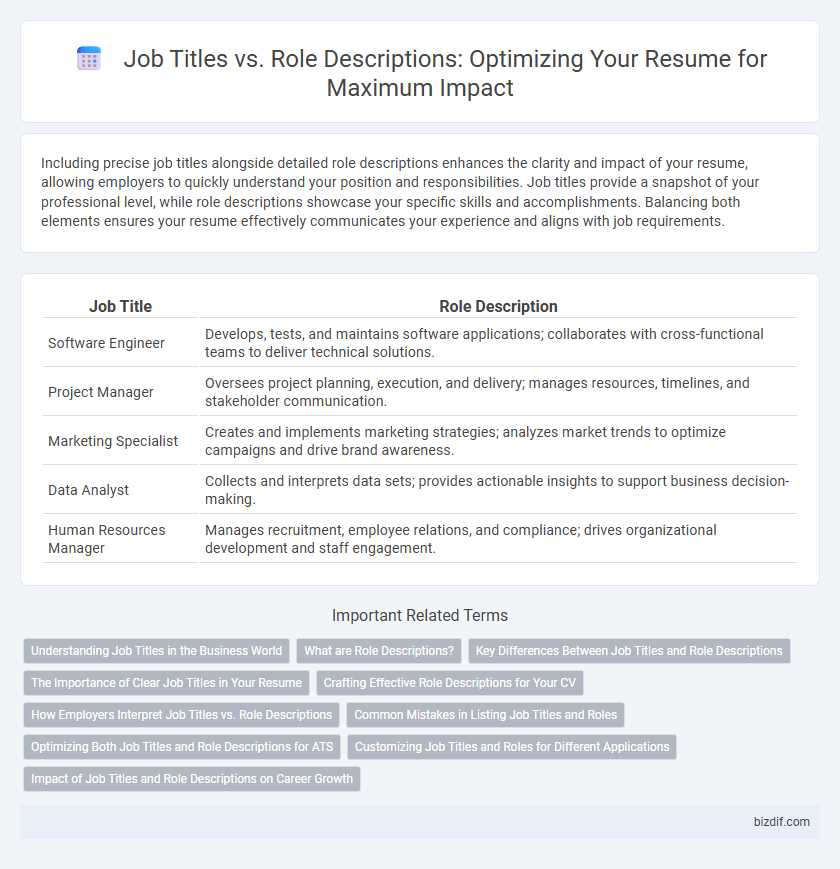Including precise job titles alongside detailed role descriptions enhances the clarity and impact of your resume, allowing employers to quickly understand your position and responsibilities. Job titles provide a snapshot of your professional level, while role descriptions showcase your specific skills and accomplishments. Balancing both elements ensures your resume effectively communicates your experience and aligns with job requirements.
Table of Comparison
| Job Title | Role Description |
|---|---|
| Software Engineer | Develops, tests, and maintains software applications; collaborates with cross-functional teams to deliver technical solutions. |
| Project Manager | Oversees project planning, execution, and delivery; manages resources, timelines, and stakeholder communication. |
| Marketing Specialist | Creates and implements marketing strategies; analyzes market trends to optimize campaigns and drive brand awareness. |
| Data Analyst | Collects and interprets data sets; provides actionable insights to support business decision-making. |
| Human Resources Manager | Manages recruitment, employee relations, and compliance; drives organizational development and staff engagement. |
Understanding Job Titles in the Business World
Job titles serve as standardized labels that communicate an employee's position within an organization, reflecting hierarchy and departmental function. Accurate job titles help recruiters quickly identify relevant candidates, while inconsistent or inflated titles can cause confusion and misalignment with industry standards. Understanding the nuances between job titles and role descriptions is essential to convey skills and responsibilities effectively in a resume.
What are Role Descriptions?
Role descriptions outline specific duties, responsibilities, and expectations associated with a job, providing clarity beyond generic job titles. They highlight the skills, tasks, and achievements relevant to the position, offering a detailed snapshot of one's professional contributions. Well-crafted role descriptions enhance a resume's relevance and improve keyword optimization for applicant tracking systems (ATS).
Key Differences Between Job Titles and Role Descriptions
Job titles provide a concise label summarizing a position, while role descriptions detail specific responsibilities, skills, and expectations. Job titles help employers and recruiters quickly identify the level and area of expertise, whereas role descriptions offer deeper insight into the actual duties performed. Clarifying these differences enhances resume clarity, ensuring candidates showcase relevant competencies aligned with job requirements.
The Importance of Clear Job Titles in Your Resume
Clear job titles in your resume enhance visibility in applicant tracking systems (ATS) and ensure recruiters quickly understand your professional expertise. Precise titles aligned with industry standards increase your chances of matching job openings and demonstrating relevant experience. Well-defined job titles also eliminate ambiguity, allowing your skills and achievements to stand out effectively.
Crafting Effective Role Descriptions for Your CV
Crafting effective role descriptions for your CV involves clearly detailing your key responsibilities, achievements, and the impact you had in each position to provide context beyond job titles. Use action verbs and quantifiable metrics to demonstrate your contributions and skills within specific roles. Tailoring role descriptions to align with the job you are applying for enhances relevance and increases your chances of securing interviews.
How Employers Interpret Job Titles vs. Role Descriptions
Employers often focus more on role descriptions than job titles to understand a candidate's actual skills and responsibilities, as job titles can vary significantly between companies. Detailed role descriptions provide clear insights into specific achievements, tasks, and competencies, enabling recruiters to assess relevance more accurately. Accurate portrayal of duties and quantifiable outcomes in role descriptions improves candidate evaluation beyond the ambiguity of job titles.
Common Mistakes in Listing Job Titles and Roles
Listing vague or generic job titles such as "Assistant" without specifying the actual role leads to underwhelming resumes that fail to convey expertise. Common mistakes include using inconsistent job titles that differ from those recognized by industry standards, causing confusion for Applicant Tracking Systems (ATS) and recruiters. Overemphasis on job titles rather than detailed role descriptions and measurable achievements can obscure the candidate's true capabilities and impact.
Optimizing Both Job Titles and Role Descriptions for ATS
Optimizing job titles and role descriptions for ATS requires incorporating relevant keywords that match the job posting to increase visibility. Using standardized job titles aligned with industry norms improves the chances of passing initial keyword scans. Detailed role descriptions should emphasize specific skills, achievements, and responsibilities to enhance semantic relevance and improve ATS ranking.
Customizing Job Titles and Roles for Different Applications
Customizing job titles and role descriptions in a resume improves relevance and alignment with specific job descriptions, enhancing applicant tracking system (ATS) compatibility. Tailoring these elements to reflect industry terminology and keywords increases the chances of passing automated filters and capturing hiring managers' attention. Precise customization demonstrates a clear fit for the position by emphasizing relevant skills and accomplishments tied to the targeted role.
Impact of Job Titles and Role Descriptions on Career Growth
Job titles serve as immediate identifiers that position candidates within industry hierarchies, often influencing hiring managers' initial perceptions and eligibility filters. Role descriptions provide detailed insights into specific skills, responsibilities, and achievements, directly demonstrating a candidate's value and potential impact on organizational goals. Clear, well-crafted role descriptions paired with relevant job titles enhance visibility in applicant tracking systems and increase opportunities for career advancement by aligning professional experience with targeted job criteria.
Job Titles vs Role Descriptions Infographic

 bizdif.com
bizdif.com